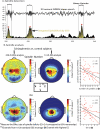The thalamic reticular nucleus and schizophrenia
- PMID: 21131368
- PMCID: PMC3044616
- DOI: 10.1093/schbul/sbq142
The thalamic reticular nucleus and schizophrenia
Abstract
Background: The thalamic reticular nucleus (TRN) is a shell-shaped gamma amino butyric acid (GABA)ergic nucleus, which is uniquely placed between the thalamus and the cortex, because it receives excitatory afferents from both cortical and thalamic neurons and sends inhibitory projections to all nuclei of the dorsal thalamus.
Method: A review of the evidence suggesting that the TRN is implicated in the neurobiology of schizophrenia.
Results: TRN-thalamus circuits are implicated in bottom-up as well as top-down processing. TRN projections to nonspecific nuclei of the dorsal thalamus mediate top-down processes, including attentional modulation, which are initiated by cortical afferents to the TRN. TRN-thalamus circuits are also involved in bottom-up activities, including sensory gating and the transfer to the cortex of sleep spindles. Intriguingly, deficits in attention and sensory gating have been consistently found in schizophrenics, including first-break and chronic patients. Furthermore, high-density electroencephalographic studies have revealed a marked reduction in sleep spindles in schizophrenics.
Conclusion: On the basis of our current knowledge on the molecular and anatomo-functional properties of the TRN, we suggest that this thalamic GABAergic nucleus may be involved in the neurobiology of schizophrenia.
Figures



References
-
- Guillery RW, Harting JK. Structure and connections of the thalamic reticular nucleus: advancing views over half a century. J Comp Neurol. 2003;463:360–371. - PubMed
-
- Krause M, Hoffmann WE, Hajos M. Auditory sensory gating in hippocampus and reticular thalamic neurons in anesthetized rats. Biol Psychiatry. 2003;53:244–253. - PubMed
-
- Guillery RW, Feig SL, Lozsadi DA. Paying attention to the thalamic reticular nucleus. Trends Neurosci. 1998;21:28–32. - PubMed
Publication types
MeSH terms
Substances
Grants and funding
LinkOut - more resources
Full Text Sources
Medical

